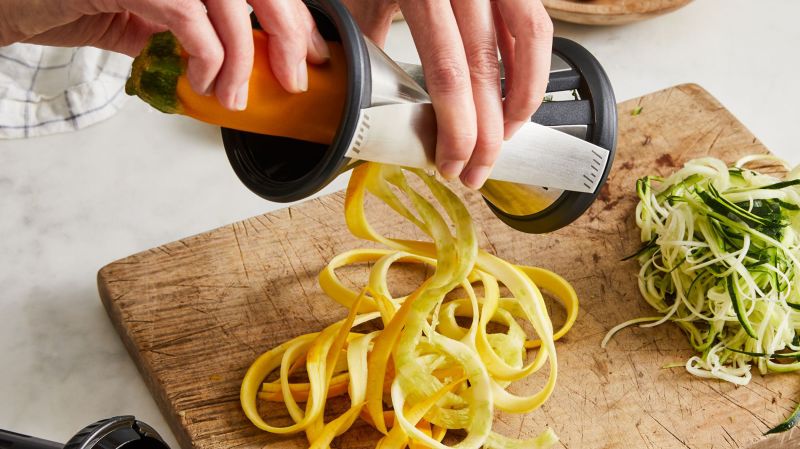In the vibrant realm of culinary exploration, the choice of cooking tools becomes a crucial ingredient in the recipe for a healthier lifestyle. The pots, pans, and utensils we use in our kitchens play a significant role not only in crafting delicious meals but also in preserving the nutritional value of our food. This article embarks on a culinary odyssey, guiding you through the art of selecting cooking tools that prioritize health and wellness.

1. The Symphony of Materials: Opting for Healthy Cookware
The overture to a healthier kitchen begins with the careful selection of cookware materials. Consider steering away from non-stick coatings that may release harmful chemicals when exposed to high temperatures. Instead, opt for stainless steel, cast iron, or ceramic cookware. These materials offer durability, even heat distribution, and are less likely to leach harmful substances into your culinary creations.
2. Stainless Steel – The Virtuoso of Versatility
Stainless steel emerges as a virtuoso in the world of cookware. Its non-reactive nature ensures that it won’t impart unwanted flavors or chemicals to your food. Stainless steel is durable, easy to clean, and resistant to corrosion. Investing in high-quality stainless steel pots and pans equips your kitchen with versatile tools that stand the test of time.
3. Cast Iron – The Timeless Conductor of Flavor
Enter the timeless conductor of flavor – cast iron cookware. Not only does cast iron lend a unique depth of taste to dishes, but it also imparts a small amount of iron to the food, fortifying your meals with an essential mineral. The even heat retention of cast iron makes it ideal for slow cooking and simmering, allowing flavors to meld and intensify.
4. Ceramic Cookware – Artistry in the Kitchen
For those who appreciate the artistry of cooking, ceramic cookware adds a touch of elegance to the kitchen. Free from harmful chemicals like PFOA and PTFE found in some non-stick coatings, ceramic pans are non-reactive and easy to clean. They provide an attractive and health-conscious option for those who seek both aesthetics and functionality in their cookware.
5. The Culinary Canvas: Wooden and Silicone Utensils
In the culinary canvas, the choice of utensils is as vital as the pots and pans themselves. Opting for wooden or silicone utensils ensures that your cookware remains scratch-free, preserving its longevity. Wooden utensils, such as bamboo spoons and spatulas, add a natural aesthetic to the kitchen and are gentle on your cookware. Silicone utensils, on the other hand, are heat-resistant and offer flexibility in various cooking tasks.
6. Cutting-Edge Choices: Knives for Precision and Safety
No culinary odyssey is complete without the right set of knives. Choosing high-quality, sharp knives not only ensures precision in your culinary endeavors but also promotes safety in the kitchen. Stainless steel or ceramic knives are excellent choices, and regular honing and sharpening maintain their effectiveness. Investing in a knife set that includes a chef’s knife, paring knife, and serrated knife equips you for a range of culinary adventures.
7. Non-Toxic Bakeware: Sweetening the Deal
As we venture into the realm of baking, selecting non-toxic bakeware becomes paramount. Steer clear of bakeware with non-stick coatings that may contain harmful chemicals. Opt for silicone baking mats, stainless steel pans, or glass bakeware. These alternatives ensure that your baked goods emerge from the oven untainted by unwanted substances, promising both flavor and health.
8. Mindful Microwave Choices: Glass and Ceramic Containers
In the modern kitchen, the microwave often plays a role in reheating and cooking. Choosing the right containers for microwave use is essential to avoid potential chemical leaching. Opt for glass or ceramic containers labeled as microwave-safe. These materials withstand heat without releasing harmful substances into your food, promoting a healthier approach to microwave cooking.
9. Water Wisdom: Choosing Safe Drinking Vessels
Beyond cooking, the vessels we use for drinking water also impact our health. Investing in BPA-free water bottles and avoiding plastic containers for long-term water storage are conscious choices. Stainless steel or glass water bottles provide safe alternatives, ensuring that the water you consume remains free from harmful chemicals that may leach from certain plastics.
10. The Spice of Life: Wooden or Glass Spice Containers
In the realm of flavor enhancement, the containers we use for spices play a subtle yet significant role. Choosing wooden or glass spice containers ensures that the vibrant flavors of your spices remain uncompromised. Wooden containers add a touch of rustic charm to your kitchen, while glass containers allow you to visually appreciate the spectrum of colors that spices bring to your culinary creations.
11. Mindful Cleaning Practices: Natural Scrubbers and Cleaning Agents
Maintaining the health-conscious journey extends to the way we clean our cookware. Opt for natural scrubbers, such as coconut husk scrubbers or wooden brushes, to avoid microplastics found in synthetic scrubbers. When it comes to cleaning agents, choose natural options like baking soda and vinegar for an eco-friendly and health-conscious approach to kitchen hygiene.
12. The Harmony of Storage: Glass and Stainless Steel Containers
As we conclude our culinary odyssey, the containers we use for food storage take center stage. Opt for glass or stainless steel containers instead of plastic for storing leftovers and prepped ingredients. These materials are non-reactive and less likely to leach harmful substances into your food. Glass containers also provide the advantage of being transparent, allowing you to easily identify the contents.
13. Culinary Mindfulness: A Symphony of Health and Flavor
In the orchestration of a healthier kitchen, the choices we make resonate as a symphony of health and flavor. By opting for cookware and utensils that prioritize both functionality and well-being, we conduct a culinary masterpiece that nourishes not only our bodies but also our appreciation for the art of cooking. As we embark on this culinary odyssey, let our kitchens become stages where the symphony of health and flavor harmonizes in every dish we create.